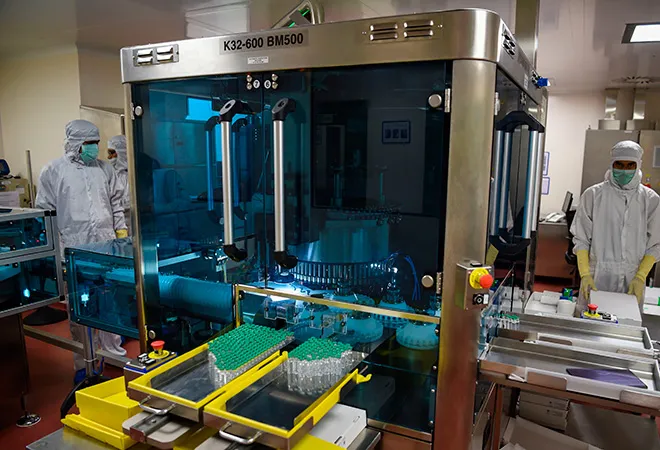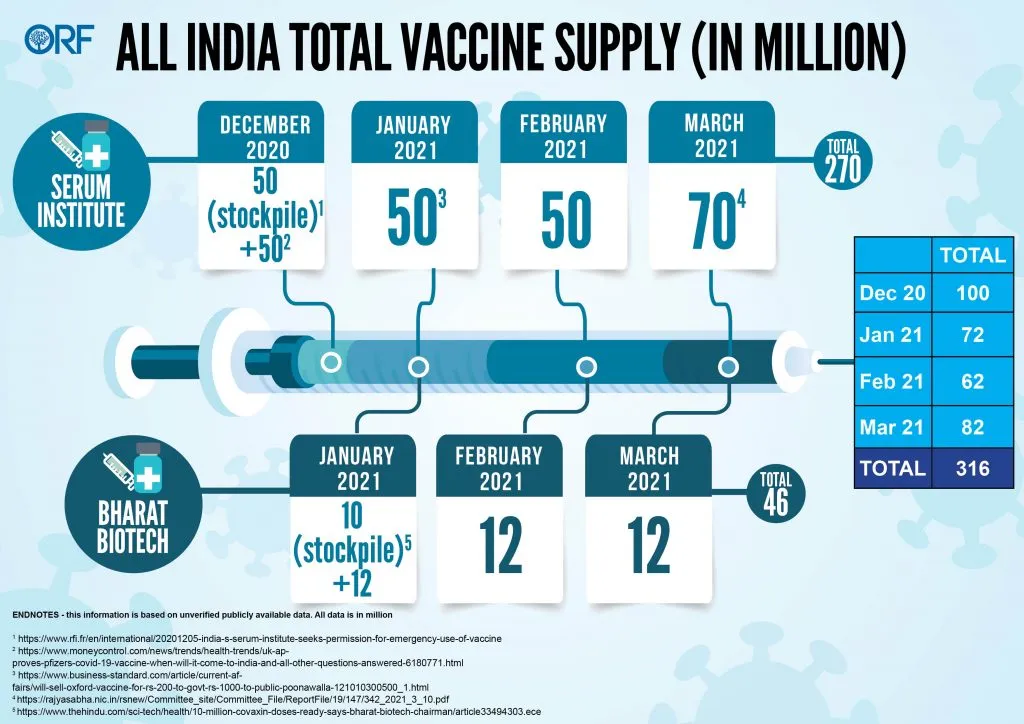
The ‘second wave’ of the novel coronavirus (SARS-CoV-2) has finally struck the second biggest nation in terms of population in the world. Amidst growing number of cases and deaths in India, the country continues to expand its vaccination drive to reach its vast population, with a focus on the highly vulnerable population and a short-term objective of preventing deaths. India’s COVID-19 vaccination drive has now shifted its focus from healthcare workers and frontline workers to those above the age of 45.
India has administered a total of
87 million shots. The country has primarily been focusing on the Oxford AstraZeneca’s vaccine Covishield, produced by Serum Institute of India (SII), along with Bharat Biotech’s Covaxin. Currently, Covisheild accounts for
91 percent of the shots in India. As opposed to the ‘self-first’ strategy adopted by many countries, India has been a global provider of the COVID vaccines in the past few months. Over
64.5 million shots have been exported to 84 countries. Out of this, 18 million were provided under the COVAX initiative, 35.7 million were commercial supplies, and 10.5 were grants to different countries.
With about 10 million people completely vaccinated, and a population of 1.3 billion, India faced an overwhelming challenge. At the current average rate of ~3 million doses a day,
estimates suggest that it will take the country 21 months to reach 75 percent of its population.
Trends in at least three countries show that COVID rates have flattened after the coverage of
40 percent of their respective population. For India to have such an impact on COVID rates, would require the covering at 520 million individuals, which at the current rate, would take about 10 more months.
As such, India’s initial goal of covering 300 million people by August can only be realized if the average rate of doses rises to 3.5 million doses a day.
Table 1: Average Estimate of vaccine doses needed and time taken to vaccinate priority population of 300 million in India
| Aug 2021 COVID Vaccine Target Population |
300,000,000 |
| Total People vaccinated in India (as on date) |
11,140,459 |
| People who have received a single shot of COVID vaccine |
75,937,015 |
|
|
| Target population yet to be vaccinated (based on Aug 2021 Goal) |
288,859,541 |
| Doses needed to vaccinate target population (2-dose assumption) |
501,782,067 |
|
|
| Average daily vaccination doses administered (7 day rolling average) |
3,093,861 |
|
|
| Days required to vaccinate target population (based on current daily average rate) |
162 |
| Months required to vaccinate target population (based on current daily average rate) |
5.4 |
|
|
| Required Daily Average to reach target population by End of August 2021 (146 days) |
3,436,863 |
India’s vaccine stockpiles
While India has been earning global goodwill for its vaccine diplomacy efforts, the rising COVID rates have raised question on India’s ability to provide for its own people. Recent reports suggest that, though India will continue to support the global community, the country will be focusing more on its domestic needs until its able to ramp up its manufacturing efforts.
A recent
research has confirmed that expanding vaccination efforts and reaching twice as many people will aid in slowing down infections and mutations. Delaying the second dose of the vaccine to 6-12 weeks seems favorable, as reaching a larger population base has more advantages.
Currently, SII, the primary producer of vaccines in India has been producing about
50-60 million doses a month on the average, adding up to a production of about 270 million doses (conservative assessment) till end March, according to publicly available data. Additionally, almost 50 million Covaxin doses have been supplied in the country. As of 17
th March, a total of 70.6 million doses of COVID vaccine have been supplied to States/UTs.
Publicly available data suggests that by March end, approximately 316 million doses of COVID vaccine have been manufactured within India (Table 2). With India’s 87 million domestic shots and 64.5 million exports, this begs the question of how the remaining vaccine doses—amounting to 164.5 million—can be accounted for? The ‘missing vaccines’ are likely in the warehouses or in the states’ vaccine cold chains; however, the latest data on the latter is awaited.
 Figure 1: Vaccine supplies based on unverified publicly available information (in million)
Figure 1: Vaccine supplies based on unverified publicly available information (in million)
Recently, the Government of India informed the Rajya Sabha that Bharat Biotech’s Covaxin has planned a production capacity of
~150 million doses a year. Post Indian government’s demand to expand production,
Bharat Biotech requested the Department of Biotechnology for additional fund up to INR 1.5 billion to expand its manufacturing capacities—INR 750 million each for both its facilities in Hyderabad and Bengaluru.
The government
informed Parliament in March that the manufacturing capacity of SII is about 70-100 million doses per month. In a recent interview, Adar Poonawalla of SII stressed that even if SII could increase its production capacity to 100 million in a month, India’s COVID vaccine drive would require multiple manufacturers to meet its needs. Responding to the government’s request of expansion,
Poonawala said he requires, “Rs 3,000-cr grant to boost vaccine capacity beyond 100 million per month”.
Firstly, the country needs to accelerate the approvals for international vaccines, especially that of single-shot vaccines such as that of Johnson & Johnson. This would greatly reduce the logistical burden the country currently faces. In addition, Indian companies have already signed contract with Russian authorities to produce more than
800 million doses of Sputnik V in India, approvals for which need to be fast-tracked as well.
Secondly, the currently dire situation of a record 115,312 new cases in a day, calls for enhanced participation of the private healthcare sector to reach the high priority demographic groups. SII stressed that while the average price of Covishield is US $20 (INR 1500), it has been providing vaccines to the Indian government at ~US $2 (INR 150). Once SII and BB push up production to the planned levels with government support, possibly a more direct interface between the vaccine makers and the healthcare providers can be explored.
In the meantime, despite the claimed production numbers over last few months painting a comfortably high supply of vaccines in the country, instances of vaccine shortage have started being reported. For instance, Maharashtra
reached out to the Centre requesting additional doses at a faster pace, citing that at the current levels of stock, they will run out of doses within the next 3 days. The state has requested a supply of 4 million doses each week to ensure keep up active vaccination drives. The government should put out timely information about vaccine doses available with the states to quell any such concerns and panic following amplified misinformation in a situation where perceived production capacity and numbers on the ground have considerable mismatch.
The views expressed above belong to the author(s). ORF research and analyses now available on Telegram! Click here to access our curated content — blogs, longforms and interviews.



 The ‘second wave’ of the novel coronavirus (SARS-CoV-2) has finally struck the second biggest nation in terms of population in the world. Amidst growing number of cases and deaths in India, the country continues to expand its vaccination drive to reach its vast population, with a focus on the highly vulnerable population and a short-term objective of preventing deaths. India’s COVID-19 vaccination drive has now shifted its focus from healthcare workers and frontline workers to those above the age of 45.
India has administered a total of
The ‘second wave’ of the novel coronavirus (SARS-CoV-2) has finally struck the second biggest nation in terms of population in the world. Amidst growing number of cases and deaths in India, the country continues to expand its vaccination drive to reach its vast population, with a focus on the highly vulnerable population and a short-term objective of preventing deaths. India’s COVID-19 vaccination drive has now shifted its focus from healthcare workers and frontline workers to those above the age of 45.
India has administered a total of  Figure 1: Vaccine supplies based on unverified publicly available information (in million)
Figure 1: Vaccine supplies based on unverified publicly available information (in million) PREV
PREV


